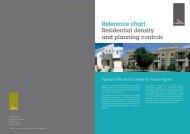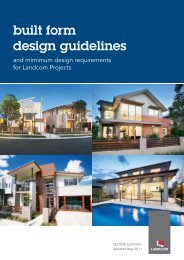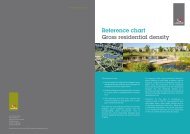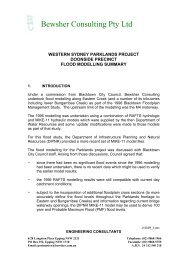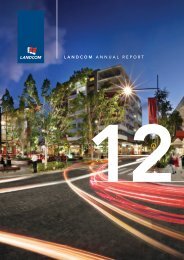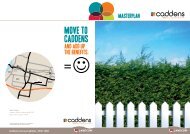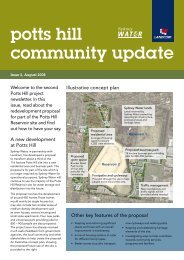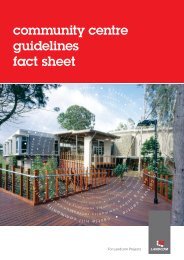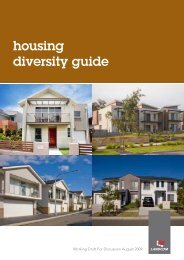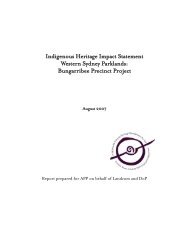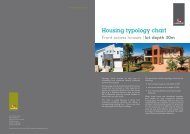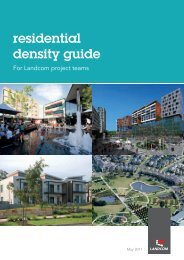WSUD Strategy
Parklands Bungarribee Precinct | WsUD Strategy Report - Landcom
Parklands Bungarribee Precinct | WsUD Strategy Report - Landcom
- No tags were found...
You also want an ePaper? Increase the reach of your titles
YUMPU automatically turns print PDFs into web optimized ePapers that Google loves.
There are minor stormwater connections across Doonside Road which discharge to the<br />
drainage pathway through the site. The drainage depression is the flow path for major<br />
flood events (that exceed the capacity of the minor drainage system) for a catchment of<br />
approximately 20ha from the south of the Great Western Highway (East of Doonside Road).<br />
A flow path will be required to ensure safe passage of significant storm events. A swale to<br />
improve water quality from the upstream catchment could be configured within the<br />
required overland flow path. This would also assist in managing the contributing flows<br />
from the development area.<br />
Flows through the depression drain around the Zone and dissipate to an ephemeral<br />
wetland area. There is no direct connection to Eastern Creek at this point through the<br />
flood plain. Development within the Institutional Zone will increase stormwater runoff and<br />
exacerbate flows which could lead to erosion of the waterway if not carefully managed. A<br />
connection to Eastern Creek may be needed to cater for the more frequent flows from the<br />
developed catchment.<br />
The development of the Zone will result in significant regrading of the site. Stormwater<br />
drainage can be addressed with underground pipes where required, however there are<br />
opportunities to sensitively integrate the development with the existing site landform.<br />
Consideration of the existing topography and natural drainage pathways is essential in<br />
moving from the initial concept planning for this area to the detailed configuration.<br />
Accommodating a swale following the natural depression through the site towards the<br />
broad floodplain area south of the confluence of Eastern and Bungarribee Creek would<br />
assist in addressing water quality in addition to integrating the required overland flow path<br />
for extreme storm events. The area also has significant native grasslands of moderate<br />
conservation value, which will influence the configuration of the development layout and<br />
integration with drainage requirements. The revegetation of the biodiversity corridor has<br />
the potential to recreate a riparian Casuarina forest near the confluence of Bungarribee and<br />
Eastern Creeks.<br />
7.2 Opportunities for <strong>WSUD</strong><br />
The optimal strategy for the inclusion of <strong>WSUD</strong> measures for both the Recreational and<br />
Institutional Zone will be depend on the specific details of the development, particularly in<br />
terms of the impervious surface area replacing existing grassland and subsequent<br />
stormwater runoff as well as the quantum of water demands. To guide the masterplanning<br />
process as the detail of the zone is refined, the following discussion is presented as<br />
potential <strong>WSUD</strong> opportunities. These <strong>WSUD</strong> opportunities include:<br />
surrounding the Zone and the downstream wetland. As this waterway is not categorised, it is<br />
possible to enhance this watercourse and embellish with an urban edge to suit the character of the<br />
development. This opportunity will assist with configuration of a required overland flow path for<br />
major storm events.<br />
The ephemeral wetland can also be modified to receive and treat flows from the development and<br />
act as a connection point between Eastern Creek and the Zone. This system could be enhanced to<br />
operate in a similar way as the billabongs adjacent to the Sports Zone.<br />
7.2.2 Stormwater management of Car Parks and other impervious areas<br />
In adopting a <strong>WSUD</strong> approach and with an understanding of embodied energy, car park design<br />
presents a significant opportunity to reduce development impacts. Car parks can be partitioned into<br />
“regularly used areas” which require pavement/concrete/asphalt and “overflow parking” which are<br />
less used and therefore can be structured turf of similar. This will limit the increase in impervious<br />
surface area associated with the development of the Zone and thereby reduce pollutant load<br />
transport to Eastern Creek and the modification to the hydrology (peak flows and volumes of<br />
stormwater runoff discharged).<br />
In terms of the regularly used areas, the pavement selection is important to ensure heat is dealt with<br />
appropriately. Efforts to shade the car parks as much as possible are recommended and will enhance<br />
the aesthetic outcomes.<br />
Bioretention systems or other measures to meet best practice water quality targets are required.<br />
Bioretention systems can provide efficient treatment of stormwater through fine filtration, extended<br />
detention and biological uptake of stormwater pollutants. They also provide flow retardation and<br />
are particularly efficient at removing nitrogen and other soluble or fine particulate contaminants.<br />
Bioretention systems are not intended to be infiltration systems in that the dominant pathway for<br />
water is not via discharge into groundwater. Rather, they convey collected water to downstream<br />
waters with any loss in runoff mainly attributed to maintaining soil moisture of the filter media itself<br />
(which is also the growing media for the vegetation). Runoff is filtered through a fine media layer as<br />
it percolates downwards. It is then collected via a perforated pipe and flows to downstream<br />
waterways or can be directed to storage for reuse.<br />
Water quality treatment measures, stormwater harvesting opportunities and overland flow paths can<br />
be configured to mitigate adverse impacts from the changes to the hydrology of the developed site.<br />
• Enhancement of the natural waterway and ephemeral wetland.<br />
• Stormwater management of the car parking and other impervious / development<br />
areas, encompassing both water quality and hydrology.<br />
• Reduction in potable mains water consumption including toilet flushing demands,<br />
air conditioning and irrigation demands.<br />
7.2.1 Enhancement of the natural depression and ephemeral wetland<br />
Development of the Recreational and Institutional Zone will lead to a greater proportion of<br />
runoff from the site which may be directed into the existing ephemeral drainage pathway<br />
Figure 7-3 Green Car Parks – with shading, bioretention systems and careful material selection<br />
Western Sydney Parklands, Bungarribee Precinct, <strong>WSUD</strong> <strong>Strategy</strong> June 2007 17



